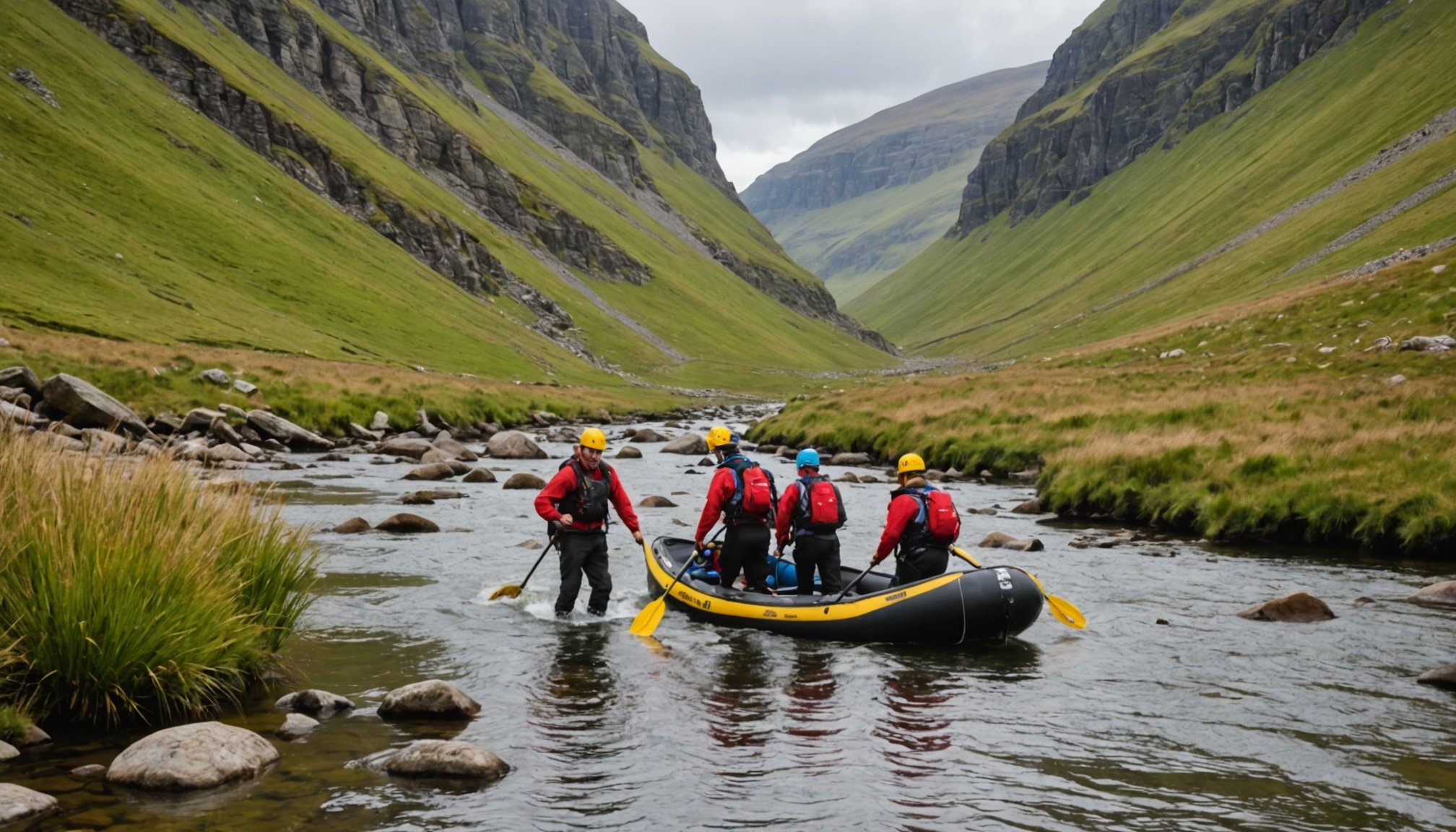Essential Safety Compliance Steps for Outdoor Adventure Companies in the UK: A Comprehensive Guide
Understanding the Importance of Safety Compliance
When it comes to outdoor adventure companies in the UK, safety compliance is not just a legal requirement, but a moral and ethical imperative. Ensuring the safety of participants, employees, and the general public is crucial for the reputation and longevity of any adventure business. Here, we will delve into the essential steps these companies must take to comply with safety regulations and maintain a safe working environment.
Identifying Relevant Legislation and Regulations
The first step in achieving safety compliance is to identify all relevant legislation and regulations that apply to your business. In the UK, outdoor adventure companies must adhere to a variety of laws and standards, including those related to health and safety, product safety, and environmental protection.
In the same genre : Essential Environmental Compliance: Key Regulations for UK Botanical Skincare Brands
Health and Safety Regulations
Health and safety regulations are paramount. The Health and Safety at Work etc. Act 1974 is a cornerstone of UK health and safety law, requiring employers to ensure the health, safety, and welfare of their employees and anyone else who might be affected by their work activities[5].
Product Safety Legislation
Product safety is another critical area. The Office for Product Safety and Standards (OPSS) oversees product safety in the UK, ensuring that products used in outdoor adventures, such as climbing equipment or kayaks, meet essential safety requirements. This includes testing methods, warning and information requirements, and compliance with specific product regulations[3].
Also to see : Essential Steps to Create a UK Social Enterprise Aimed at Combating Plastic Waste
Conducting Risk Assessments
Risk assessments are a fundamental part of safety compliance. These assessments help identify potential hazards and implement measures to mitigate them.
Types of Risk Assessments
- General Risk Assessments: These are comprehensive evaluations of the workplace and activities to identify any potential risks. For example, assessing the terrain for hiking trips or evaluating the condition of climbing equipment.
- Specific Risk Assessments: These focus on specific activities or equipment, such as assessing the safety of zip lines or white-water rafting equipment.
- Dynamic Risk Assessments: These are ongoing assessments that take place during the activity itself, allowing for real-time adjustments to ensure safety.
Steps in Conducting a Risk Assessment
- Identify Hazards: Look for anything that could cause harm.
- Assess the Risks: Evaluate the likelihood and potential impact of each hazard.
- Implement Controls: Put in place measures to reduce or eliminate the risks.
- Monitor and Review: Regularly review and update the risk assessment to ensure it remains effective.
Implementing Safety Policies and Procedures
Developing and implementing robust safety policies and procedures is essential for maintaining compliance.
Key Policies and Procedures
- Emergency Response Plans: Detailed plans outlining what to do in case of an emergency, such as a fire or medical incident.
- Equipment Maintenance: Regular maintenance schedules for all equipment to ensure it remains in good working order.
- Training Programs: Comprehensive training for staff on safety procedures, first aid, and the use of equipment.
- Health and Safety Signage: Clear and visible signage indicating emergency exits, fire assembly points, and other safety information[1].
Ensuring Compliance with Fire Safety Regulations
Fire safety is a critical aspect of overall safety compliance, especially in outdoor settings where fires can quickly spread.
Key Fire Safety Measures
- Appoint a Responsible Person: Designate someone with the authority and experience to manage fire safety.
- Fire Risk Assessments: Conduct regular fire risk assessments to identify potential fire hazards.
- Fire Safety Equipment: Ensure all fire safety equipment, including fire alarms, extinguishers, and emergency lighting, is checked, tested, and serviced regularly.
- Fire Drills: Conduct regular fire drills to ensure everyone knows what to do in case of a fire[1].
Maintaining Site Safety
Site safety is crucial for outdoor adventure companies, whether it involves setting up a temporary campsite or managing a permanent facility.
Essential Site Safety Measures
- Clear Escape Routes: Ensure all exit routes are clear and free from obstructions.
- Proper Storage of Flammable Materials: Store flammable materials securely away from potential ignition sources, as required by the Dangerous Substances and Explosive Atmospheres Regulations (DSEAR)[5].
- Regular Inspections: Conduct regular inspections of the site to identify and mitigate any potential hazards.
Training and Awareness Programs
Training and awareness programs are vital for ensuring that all staff and participants understand and adhere to safety protocols.
Types of Training
- Health and Safety Training: Training on general health and safety procedures, including risk assessments and emergency response plans.
- Equipment Training: Specific training on the use and maintenance of equipment.
- First Aid Training: Training in first aid to handle common injuries such as burns, cuts, and eye trauma[5].
Best Practices for Training
- Regular Updates: Ensure training programs are regularly updated to reflect any changes in regulations or best practices.
- Interactive Training: Use interactive methods such as simulations and hands-on training to engage participants.
- Certification: Ensure that all training is certified and recognized by relevant authorities.
Monitoring and Auditing Compliance
Continuous monitoring and auditing are essential to ensure that safety compliance efforts remain effective.
Monitoring Compliance
- Regular Checks: Conduct regular checks on safety equipment, procedures, and training to ensure they are up-to-date and effective.
- Incident Reporting: Have a system in place for reporting incidents or near-misses, which can help identify areas for improvement.
Auditing Compliance
- Internal Audits: Conduct periodic internal audits to review compliance across all departments and identify any emerging risks or areas of non-compliance.
- External Audits: Engage in external audits by third-party assessors to verify adherence to specific standards and regulations[2].
Product Safety and UKCA Marking
For outdoor adventure companies that use or supply products, ensuring product safety is crucial.
UKCA Marking
- What is UKCA Marking?: The UKCA (UK Conformity Assessed) marking is a certification mark that indicates a product complies with the relevant UK regulations.
- Relevant Legislation: Products must comply with relevant UK product regulations, such as those related to machinery, electrical equipment, and personal protective equipment.
- Conformity Assessment: Conduct conformity assessments to ensure products meet the essential safety requirements. This may involve third-party testing or in-house testing with suitable accreditations[3].
Practical Insights and Actionable Advice
Here are some practical insights and actionable advice to help outdoor adventure companies in the UK maintain robust safety compliance:
Example: Fire Safety Log Book
- Maintaining a Fire Safety Log Book: If you employ five or more staff, you must document your fire safety management records. A fire safety log book helps in recording checks, tests, and any defects found in fire safety equipment[1].
Example: Risk Management for Travel
- Travel Risk Management: For companies whose employees travel for work, ensuring travel risk management is in place is crucial. This includes authorizing travel, briefing travelers on risks, and maintaining contact during travel[4].
Safety compliance is not a one-time task but an ongoing process that requires continuous effort and vigilance. By understanding the relevant legislation, conducting thorough risk assessments, implementing robust safety policies, ensuring compliance with fire safety regulations, maintaining site safety, providing comprehensive training, and monitoring and auditing compliance, outdoor adventure companies in the UK can create a safe and enjoyable experience for all participants.
Table: Key Safety Compliance Steps for Outdoor Adventure Companies
| Compliance Area | Key Steps | Relevant Legislation/Regulations |
|---|---|---|
| Health and Safety | Conduct risk assessments, implement safety policies, provide training | Health and Safety at Work etc. Act 1974 |
| Fire Safety | Appoint a responsible person, conduct fire risk assessments, maintain fire safety equipment | The Regulatory Reform (Fire Safety) Order 2005 |
| Product Safety | Ensure products meet essential safety requirements, conduct conformity assessments, use UKCA marking | Product Safety and Metrology etc. Act 2020 |
| Site Safety | Ensure clear escape routes, store flammable materials securely, conduct regular inspections | Dangerous Substances and Explosive Atmospheres Regulations (DSEAR) |
| Training and Awareness | Provide health and safety training, equipment training, first aid training | Health and Safety at Work etc. Act 1974 |
| Monitoring and Auditing | Conduct regular checks, report incidents, conduct internal and external audits | Compliance Management Process |
Detailed Bullet Point List: Essential Safety Equipment Checks
-
Fire Extinguishers:
-
Ensure they are easily accessible and clearly marked.
-
Conduct regular checks to ensure they are fully charged and functional.
-
Record findings in the fire safety log book.
-
Emergency Lighting:
-
Ensure it is functioning correctly.
-
Conduct annual checks by an independent third party.
-
Replace any worn or missing parts.
-
Fire Alarms:
-
Test smoke alarms monthly and change batteries every six months.
-
Ensure the fire alarm system is checked and serviced in line with BS5839-1:2017.
-
Fire Doors:
-
Ensure fire doors have fire door signs fitted and are installed correctly.
-
Maintain fire doors to satisfactory standards.
-
Firefighting Equipment:
-
Test fire hose reels every six months for damage and wear.
-
Check fire blankets biannually to ensure they are effective.
Quotes from Experts
- “Ensuring compliance with safety regulations is not just about avoiding legal penalties; it’s about protecting the lives and well-being of your employees and customers,” says Alex Minett, a safety compliance expert.
- “Regular training and awareness programs are crucial for maintaining a safe working environment. It’s not just about ticking boxes; it’s about creating a culture of safety,” emphasizes a health and safety trainer.
By following these steps and integrating them into your business operations, outdoor adventure companies in the UK can ensure a safe, compliant, and successful operation. Remember, safety compliance is an ongoing commitment that requires continuous effort and dedication.
Conducting Comprehensive Risk Assessments
Conducting a risk assessment in outdoor activities, such as adventure sports, involves meticulous planning and evaluation to ensure safety management. The process begins with identifying hazards that could pose risks. One must consider environmental factors, equipment condition, and the skill levels of participants.
Once hazards are identified, the next step involves evaluating the risks associated with each. This includes estimating the potential impact and likelihood of each risk occurring. Calculating the risks involves using specific tools and methodologies, such as risk matrices. These aid in quantifying and prioritizing risks effectively.
Implementing risk assessments into daily operations greatly enhances safety management. This integration allows staff to incorporate safety protocols in decision-making processes, ensuring that activities proceed with minimal risk.
Tools like checklists and digital platforms simplify capturing and updating risk information. Regular reviews and updates to risk assessments ensure their relevance and effectiveness over time. By focusing on comprehensive evaluations and adapting to new challenges, managing risk becomes a proactive element in the safety management of adventure sports, promoting both participant well-being and the overall success of the activities.











